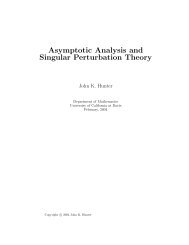Bounded Linear Operators on a Hilbert Space
Bounded Linear Operators on a Hilbert Space
Bounded Linear Operators on a Hilbert Space
You also want an ePaper? Increase the reach of your titles
YUMPU automatically turns print PDFs into web optimized ePapers that Google loves.
The mean ergodic theorem 203<br />
random variable. Since T is measure preserving, we have Ef = Ef ◦ T , or<br />
<br />
f dP = f ◦ T dP.<br />
Ω<br />
If f = f ◦ T , then we say that f is invariant under T . This is always true if f is a<br />
c<strong>on</strong>stant functi<strong>on</strong>. If these are the <strong>on</strong>ly invariant functi<strong>on</strong>s, then we say that T is<br />
ergodic.<br />
Definiti<strong>on</strong> 8.36 A <strong>on</strong>e-to-<strong>on</strong>e, <strong>on</strong>to, measure preserving map T <strong>on</strong> a probability<br />
space (Ω, P ) is ergodic if the <strong>on</strong>ly functi<strong>on</strong>s f ∈ L 2 (Ω, P ) such that f = f ◦ T are<br />
the c<strong>on</strong>stant functi<strong>on</strong>s.<br />
For example, rotati<strong>on</strong>s of the circle through an irrati<strong>on</strong>al multiple of 2π are<br />
ergodic, but rotati<strong>on</strong>s through a rati<strong>on</strong>al multiple of 2π are not. To make the<br />
c<strong>on</strong>necti<strong>on</strong> between ergodic maps and Theorem 8.35 above, we define an operator<br />
Ω<br />
U : L 2 (Ω, P ) → L 2 (Ω, P )<br />
<strong>on</strong> the <strong>Hilbert</strong> space L 2 (Ω, P ) of sec<strong>on</strong>d-order random variables <strong>on</strong> Ω by<br />
Uf = f ◦ T. (8.16)<br />
Suppose that f, g ∈ L2 (Ω, P ). Then, since T is measure preserving, we have<br />
<br />
<br />
〈Uf, Ug〉 = f (T (ω))g (T (ω)) dP (ω) = f(ω)g(ω) dP (ω) = 〈f, g〉,<br />
Ω<br />
so the map U is unitary. The subspace of functi<strong>on</strong>s invariant under U c<strong>on</strong>sists of the<br />
functi<strong>on</strong>s that are invariant under T . Thus, if T is ergodic, the invariant subspace<br />
of U c<strong>on</strong>sists of the c<strong>on</strong>stant functi<strong>on</strong>s, and the orthog<strong>on</strong>al projecti<strong>on</strong> <strong>on</strong>to the<br />
invariant subspace maps a random variable to its expected value. An applicati<strong>on</strong><br />
of the v<strong>on</strong> Neumann ergodic theorem to the map U defined in (8.16) then gives the<br />
following result.<br />
Theorem 8.37 A <strong>on</strong>e-to-<strong>on</strong>e, <strong>on</strong>to, measure preserving map T : Ω → Ω <strong>on</strong> a<br />
probability space (Ω, P ) is ergodic if and <strong>on</strong>ly if for every f ∈ L 2 (Ω, P )<br />
1<br />
lim<br />
N→∞ N + 1<br />
Ω<br />
N<br />
f ◦ T n <br />
=<br />
n=0<br />
where the c<strong>on</strong>vergence is in the L 2 -norm.<br />
Ω<br />
fdP, (8.17)<br />
If we think of T : Ω → Ω as defining a discrete dynamical system xn+1 = T xn<br />
<strong>on</strong> the state space Ω, as described in Secti<strong>on</strong> 3.2, then the left-hand side of (8.17) is<br />
the time average of f, while the right-hand side is the probabilistic (or “ensemble”)<br />
average of f. Thus, the theorem states that time averages and probabilistic averages<br />
coincide for ergodic maps.
















